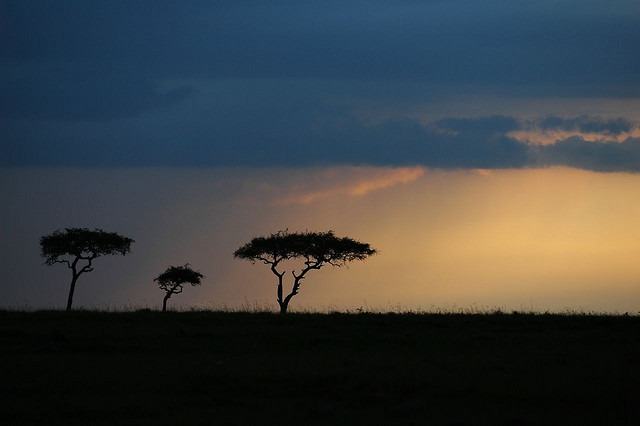
Density matters. That’s the premise of this blog, after all. The number of people per square mile influences the character of a place—a topic I’ve covered repeatedly—but human population density isn’t everything. Take savannas. They are ecosystems defined by density.
Savannas are grasslands dotted with trees—not too many and not too few. They can have no less than 20 percent tree cover and no more than 80 percent. They exist thanks to fire, a devastatingly destructive natural process that keeps the trees in check. If fires occur too often, they will strip a savanna of its trees and revert it to prairie. If they become to infrequent, trees will takeover and the savanna will become a forest. Yet for all its power in shaping ecosystems, fire matters inasmuch as it can keep trees from breaking through to the canopy. Growth is a tree’s countermeasure. If a sapling can stretch skywards with enough haste, its tender apical buds can escape a fire’s most intense heat and survive. Savannas are shaped by more than just frequency of fire, then. They are held in balance between destruction and development.
That balance is confirmed by a study of three Acacia species—A. karroo, A. gerrardii, and A. tortolis—in South African savannas. The paper’s authors wanted to see what it takes for a tree to reach the canopy before fire returned. In South African savannas, that’s quite a lot. Fires typically burn every 2.9 years in drier areas and every 3.8 years in wetter areas. Occasionally, the interval slips to 10 years. Between 2000 and 2007 when the scientists were measuring the trees, three fires swept through—one each in 2000, 2002, and 2004.
Most trees couldn’t grow fast enough. On average, A. tortolis and A. gerrardii saplings grew about 11 to 14 cm per year, respectively, A. karroo saplings at 25 cm per year. None of these are quick enough for the trees to make it to the canopy height of 3 meters (about 10 feet) in 10 years, let alone a more typical 3 to 4 year interval.
The saplings most likely to make it to the canopy, the ecologists found, were the swiftest growers. In the savanna, “Only the exceptional become trees,” the authors wrote. They speculate that savanna canopy trees are not only bequeathed with superior genes, they also have the good fortune of growing in rich, wet soil without suffering ravenous herbivores or stiff competition from grass. But even with all these advantages, the fleetest 5 percent still need longer than 3 to 4 years to graduate to the canopy. Longer fire-free periods appear to be necessary to maintain a savanna.
Density in the savanna is the result of a complex set of processes that settle into a delicate balance. There’s so much going on it’s like a symphony of ecological interactions: Staccato fires interrupted by brief yet unpredictable intermissions, an orchestra of trees performing a slow march, and a handful of virtuoso trees playing at a furious pace.
Savannas occupy a sweet spot of tree densities, one that is both visually appealing and ecologically important. One of the largest savannas, the Serengeti, is home to some of the world’s most charismatic fauna. Others probably fostered the rise of our own species. Even more prosaic ones host thousands of wonderful and endangered species. But savannas are imperiled, with fire suppression turning them into forests and climate change messing the life cycles of their constituent species. Anything that upsets one part of a savanna or another threatens to undo the whole system. That’s precisely why they are among the world’s most endangered ecosystems, and why they need to be protected.
Source:
Wakeling, J., Staver, A., & Bond, W. (2011). Simply the best: the transition of savanna saplings to trees Oikos DOI: 10.1111/j.1600-0706.2011.19957.x
Photo by Kalense Kid.
Related posts: